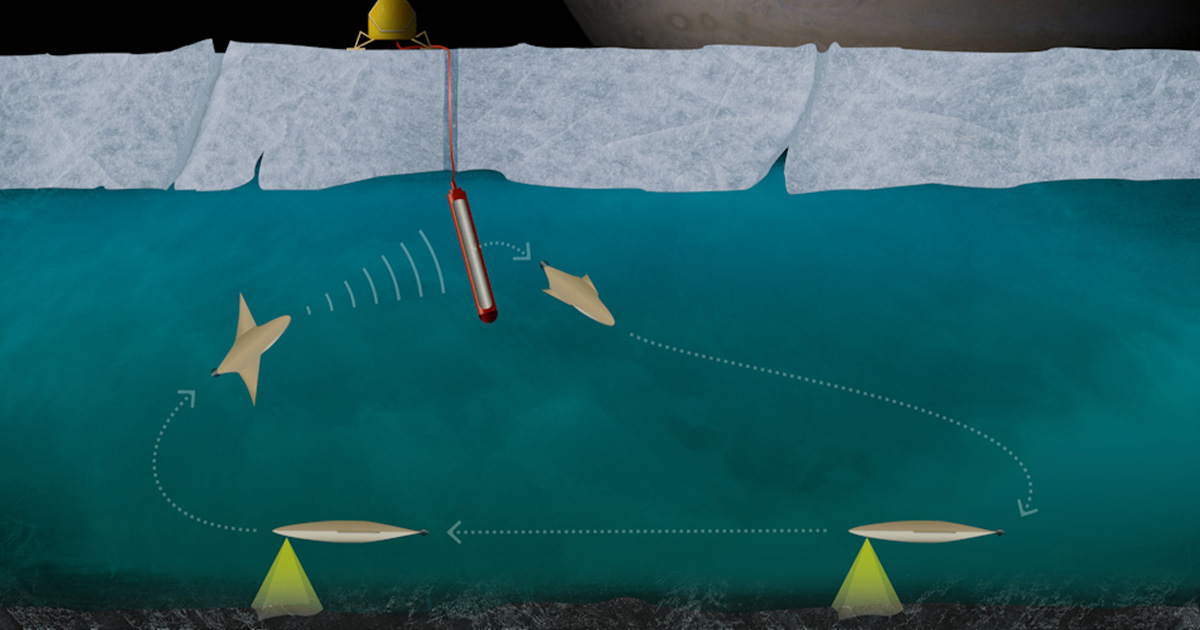For years, scientists have assumed that there are oceans of water beneath the ice covers on the moons Enceladus and Europa. Even in outer space, the presence of water can suggest the possibility of life, even when it is located beneath an ice layer.
The investigation of such water bodies lying kilometers below an ice sheet on the Earth, however, is an immense challenge, and even more so in outer space.
How can high-technology tools penetrate the thick ice crust, and how can the exploration of the underlying ocean be carried out under the extreme environmental conditions that exist there? What kinds of scientific sensors are necessary in the search for signs of life there? How can samples be retrieved? How can all this be achieved without contaminating an ecosystem as yet unknown?
The collaborative project TRIPLE-nanoAUV 2, coordinated at MARUM, primarily exists to address the technological challenges. The acronym TRIPLE stands for “Technologies for Rapid Ice Penetration and subglacial Lake Exploration.” Along with the TRIPLE collaborative projects TRIPLE-GNC and TRIPLE-LifeDetect, the project is part of the DLR Explorer initiatives. Developments in the TRIPLE projects will be combined in Phase 2 and tested jointly during a field trial under the Antarctic ice shelf near the Neumayer III Station in the spring of 2026.
For this, a small Autonomous Underwater Vehicle (AUV) as well as an LRS (Launch and Recovery System) will be constructed at MARUM in cooperation with industrial partners from the aerospace and underwater-acoustic fields, as well as from the other related TRIPLE projects. The LRS will enable the nanoAUV to dock with an underwater station in order to transmit the collected data and charge its batteries, which will allow it to stay under water longer. Because the vehicle has to be transported through the ice as payload within a melting probe, it will be much smaller than is usual for underwater vehicles, with a diameter of about ten and a length of about 50 centimeters.
It is believed that there are unknown ecosystems in the subglacial lakes beneath the continental ice of Antarctica. Technologically, exploration of the water body, which is covered by up to 4,000 meters of ice, is extremely demanding. “Such nano-vehicles can help to provide a better overall understanding of marine ecosystems,” says project leader Prof. Ralf Bachmayer of MARUM—Center for Marine Environmental Sciences at the University of Bremen. “The new autonomous system is unique and should make it possible in the future to study the global liquid-water ocean below the icy surfaces of Jupiter’s moon Europa and Saturn’s moon Enceladus. Miniaturization is the primary challenge in its development, with the probe dictating the overall size. In addition, all of the components must be able to withstand the high pressure under water.”
“The objective is to garner expertise within the DLR Explorer initiatives that could be used in a possible international space mission,” explains leading engineer Sebastian Meckel. “The first field tests will deploy the melting probe with the nanoAUV integrated as payload in ice with a thickness of 100 meters. In addition, the nanoAUV is underactuated compared to larger autonomous vehicles, meaning it has limited maneuverability. This necessitates an extremely high reliability and close coordination among the associates from TRIPLE-GNC and TRIPLE-LifeDetect."
The project is a follow-up to the collaborative projects TRIPLE-nanoAUV1 and TRIPLE-MoDo, and expands on development concepts for the autonomous vehicle and a docking station. In the parallel project TRIPLE-IceCraft, the melting probe, which will penetrate the ice cover at Neumayer III and deliver the nanoAUV into the underlying water, has already been developed. Other associated projects are developing, among others, the navigation software and scientific payload for the autonomous vehicle. In addition, findings from the ROBEX project, in which MARUM was also significantly involved, are also included. This is the first time that space and deep-sea research have been combined and robotic systems developed for extreme environments.
MARUM and the University of Bremen are coordinating the current project, with company partners DSI Aerospace Technologie GmbH in Bremen and EvoLogics GmbH in Berlin. The project has a total funding volume of 2.68 million Euros and runs through September 2026. The overall coordination of the TRIPLE project line is being carried out by the German Space Agency at DLR. In addition to TRIPLE-nanoAUV, parts of the second phase include the parallel projects TRIPLE-GNC (Guidance, Navigation and Control), TRIPLE-LifeDetect (scientific payload), and TRIPLE-FRS 2 (Forefield Reconnaissance System, for implementation in the melting head of the ice-melting probe). The TRIPLE project line is a division of the DLR Explorer Initiatives.



